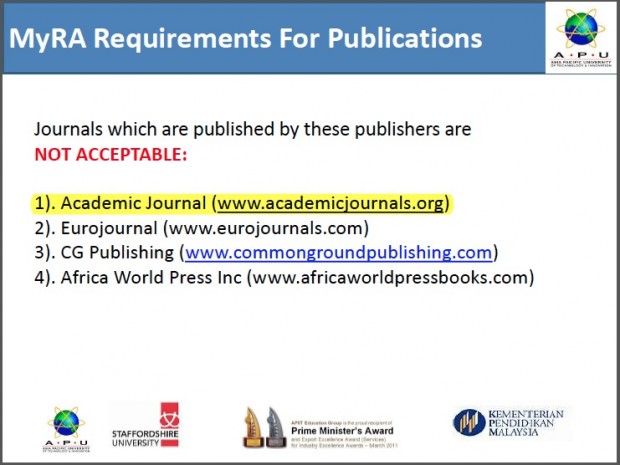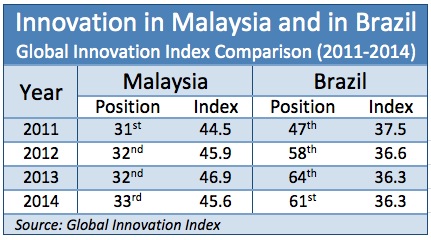(Translation of the post “Na ciência, o ruim para a Malásia é bom para o Brasil”, March 7.)
By MAURÍCIO TUFFANI

Since 2010, the Ministry of Higher Education of Malaysia does not recognize articles of its researchers in journals of a Nigerian academic press and also does not give financial support for the publication of studies on them. But in Brazil, since the triennial rating of graduate programs completed in 2013 by MEC (Ministry of Education of Brazil), 13 journals of that same publisher, were included on the online Qualis Periódicos database, which serves to guide researchers, professors and graduate students to choose scientific publications for their work.
The Nigerian publisher is Academic Journals, which uses a very similar name to the American Academic Journals Inc. In early 2013, warnings on the Internet about the poor quality of academic publishers from that country were made by vehicles on scientific communication, such as the Scidev.Net (Jan/21/2013), and by the journal “Nature” (Mar/27/2013).
Besides this divulgation, which was still recent, it had been at least two years that the press, scientific institutions and researchers were reverberating on the Internet, the inclusion of this publisher in the list of “predatory publishers” of the “Scholarly Open Access” blog of the academic librarian Jeffrey Beall, Professor at the University of Colorado at Denver (USA), who became a reference on the subject.
And since the end of 2010 several academic reports from Malaysia already included this Nigerian publisher in their reminders about periodicals not recognized by the country’s higher education system due to unethical practices and other reasons.
Indifference
Despite all this information that in the early 2013 were more than enough to at least evaluate with increased attention all that concerned the Academic Journals, it seems to have been no objection to 13 journals from this publisher in the triennial rating completed that year by CAPES (Coordination for the Improvement of Higher Education Personnel) through 29 of its 48 committees advisers -—each one with a coordinator, two assistant coordinators and 20 specialized consultants on the average.
The following is a list of these journals with their publication fees for free access on the internet, charged by Academic Journals for each article. The ones who pay are the authors, who are often subsidized by the institutions in which they work.
- “African Journal of Agricultural Research” ($ 600 USD)
- “African Journal of Biotechnology” ($ 650 USD)
- “African Journal of Business Management” ($ 550 USD
- “African Journal of Food Science” ($ 550 USD)
- “African Journal of Microbiology Research” ($ 550 USD)
- “African Journal of Pharmacy and Pharmacology” ($ 600 USD)
- “Educational Research and Reviews” ($ 550 USD)
- “International Journal of Sociology and Anthropology” ($ 550 USD)
- “Journal of Accounting and Taxation” ($ 550 USD)
- “Journal of Horticulture and Forestry” ($ 550 USD)
- “Journal of Medicinal Plants Research” ($ 600 USD)
- “Journal of Public Health and Epidemiology” ($ 650 USD)
- “Scientific Research and Essays” ($ 550 USD)
A simple and random search for articles from these journals shows that it is frequently the acceptance of papers for publication in about a month after they were submitted for publication by their authors.
With the most prestigious journals —free or paid access— this time frame take several months and can exceed one year. The process involves several steps, such as prior assessment by the editors, analysis by one or more consultants and further review. Not to mention the return to the authors for clarification or corrections and other measures, when there is no rejection.
Damage
Before the complaints begin, I clarify that all this does not mean that all studies published by these magazines are of poor quality. What is at stake is not only the damage to the work of our researchers and the Brazilian scientific production in terms of international recognition, but also the pernicious expansion of lower standards of scholarly communication and, moreover, the vulnerability of the rating done by CAPES.
Nor am I considering Malaysia a model for Brazil. But some lesson we can learn from that country’s performance with regards to graduate programs and science policy. Including due to the comparative performance with Brazil, as shown in the following table, based on the five most recent ratings of the Global Innovation Index of Cornell University and of the WIPO (World Intellectual Property Organization).

Comparison
While in the 2011-2014 period, Brazil dropped 14 positions in world ranking of innovation, staying below other Latin American countries, Malaysia lost only two positions. And, by the way, in a much more fierce competition with European and Asian tigers.
Moreover, at the same time Brazil lost 1.2 points while Malaysia increased by 1.1 in the Global Innovation Index. The score is calculated based on indicators in various areas, such as basic and higher education, investment in education and in research and development, regulatory and political environment, sustainability and environment, generation and impact of knowledge among others.
Besides being a period of the most negative of the Brazilian economy; 2014 was the year in which our country stood out badly also by its stagnation in innovation, that in April resulted in a provocative article “The 50-year snooze” by the British magazine “The Economist”. The text made an association of our traffic jams, long lines, missed deadlines and delays with the insignificant performance of the country in innovation, including in relation to other Latin American and Caribbean countries.
Nothing to declare
The Academic Journals ignored the questions that were sent on Tuesday (Mar/03/2015) by its “contact us” form, typical of many of the ill-respected academic publishers that do not provide email contact.
And, almost as copy-and-paste of what I said in my post yesterday (Fake Professor edits journal selected by CAPES), I clarify that the MEC agency stated on Thursday (Mar/02/2015) that it will not make more comments, claiming that all that it could be said is already in its last week’s note in response to questions sent to the report “Slot machines scientific events worries Brazilian scientists”.
The CAPES note, which can be read in full on the text about slot machines events, dismissed my questions about irregularities in the inclusion of other journals. According to the evasive answer, the inclusion of journals in the Qualis is based in the Brazilian academic production during the period corresponding to the quality rating of graduate programs.
In other words, the 13 journals of Academic Journals entered Qualis because Brazilian professors and researchers published thousands of articles in them for the period 2010 to 2012. But it does not explain why the nearly 1,400 experts from 29 advisory committees of the MEC agency have not seen objections for them to stay in that selection. A Google search indicates that it would be about 3,890 articles, which would correspond, based on the minimum of $ 550 per article, to a Brazilian expenditure of $ 2.14 million USD.
I just hope that the comparison I made with Malaysia will not provide an argument to create in Brazil another ministry, the Higher Education.
